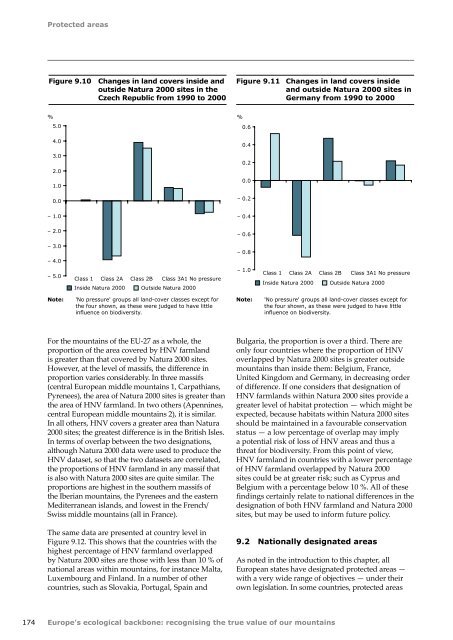Europes ecological backbone.pdf
Europes ecological backbone.pdf
Europes ecological backbone.pdf
You also want an ePaper? Increase the reach of your titles
YUMPU automatically turns print PDFs into web optimized ePapers that Google loves.
Protected areas<br />
Figure 9.10 Changes in land covers inside and<br />
outside Natura 2000 sites in the<br />
Czech Republic from 1990 to 2000<br />
Figure 9.11 Changes in land covers inside<br />
and outside Natura 2000 sites in<br />
Germany from 1990 to 2000<br />
%<br />
5.0<br />
4.0<br />
3.0<br />
2.0<br />
1.0<br />
0.0<br />
%<br />
0.6<br />
0.4<br />
0.2<br />
0.0<br />
– 0.2<br />
– 1.0<br />
– 2.0<br />
– 0.4<br />
– 0.6<br />
– 3.0<br />
– 0.8<br />
– 4.0<br />
– 5.0<br />
Class 1 Class 2A Class 2B Class 3A1 No pressure<br />
Inside Natura 2000 Outside Natura 2000<br />
– 1.0<br />
Class 1 Class 2A Class 2B Class 3A1 No pressure<br />
Inside Natura 2000 Outside Natura 2000<br />
Note:<br />
'No pressure' groups all land‐cover classes except for<br />
the four shown, as these were judged to have little<br />
influence on biodiversity.<br />
Note:<br />
'No pressure' groups all land‐cover classes except for<br />
the four shown, as these were judged to have little<br />
influence on biodiversity.<br />
For the mountains of the EU‐27 as a whole, the<br />
proportion of the area covered by HNV farmland<br />
is greater than that covered by Natura 2000 sites.<br />
However, at the level of massifs, the difference in<br />
proportion varies considerably. In three massifs<br />
(central European middle mountains 1, Carpathians,<br />
Pyrenees), the area of Natura 2000 sites is greater than<br />
the area of HNV farmland. In two others (Apennines,<br />
central European middle mountains 2), it is similar.<br />
In all others, HNV covers a greater area than Natura<br />
2000 sites; the greatest difference is in the British Isles.<br />
In terms of overlap between the two designations,<br />
although Natura 2000 data were used to produce the<br />
HNV dataset, so that the two datasets are correlated,<br />
the proportions of HNV farmland in any massif that<br />
is also with Natura 2000 sites are quite similar. The<br />
proportions are highest in the southern massifs of<br />
the Iberian mountains, the Pyrenees and the eastern<br />
Mediterranean islands, and lowest in the French/<br />
Swiss middle mountains (all in France).<br />
The same data are presented at country level in<br />
Figure 9.12. This shows that the countries with the<br />
highest percentage of HNV farmland overlapped<br />
by Natura 2000 sites are those with less than 10 % of<br />
national areas within mountains, for instance Malta,<br />
Luxembourg and Finland. In a number of other<br />
countries, such as Slovakia, Portugal, Spain and<br />
Bulgaria, the proportion is over a third. There are<br />
only four countries where the proportion of HNV<br />
overlapped by Natura 2000 sites is greater outside<br />
mountains than inside them: Belgium, France,<br />
United Kingdom and Germany, in decreasing order<br />
of difference. If one considers that designation of<br />
HNV farmlands within Natura 2000 sites provide a<br />
greater level of habitat protection — which might be<br />
expected, because habitats within Natura 2000 sites<br />
should be maintained in a favourable conservation<br />
status — a low percentage of overlap may imply<br />
a potential risk of loss of HNV areas and thus a<br />
threat for biodiversity. From this point of view,<br />
HNV farmland in countries with a lower percentage<br />
of HNV farmland overlapped by Natura 2000<br />
sites could be at greater risk; such as Cyprus and<br />
Belgium with a percentage below 10 %. All of these<br />
findings certainly relate to national differences in the<br />
designation of both HNV farmland and Natura 2000<br />
sites, but may be used to inform future policy.<br />
9.2 Nationally designated areas<br />
As noted in the introduction to this chapter, all<br />
European states have designated protected areas —<br />
with a very wide range of objectives — under their<br />
own legislation. In some countries, protected areas<br />
174 Europe's <strong>ecological</strong> <strong>backbone</strong>: recognising the true value of our mountains

















